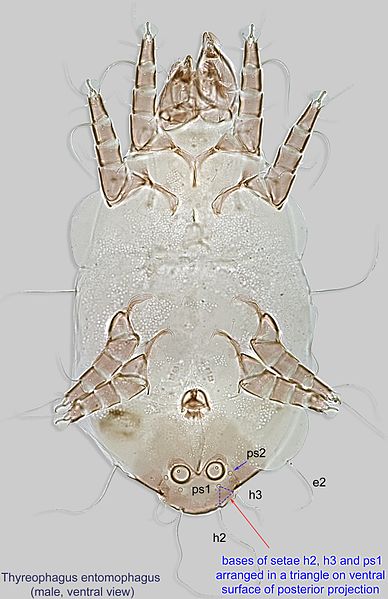In this post, I will dissect this article, and provide an introduction to how you might rear predatory mites, as well as some species comparisons.
Common Biocontrol Mites:
Amblyseius swirskii– Useful for thrip control in warm, humid climates.
Phytoseiulus persimilis– An obligate spider mite predator (Tetranchus spp.), especially useful against two-spotted spider mites, Tetranychus urticae. This can be disadvantageous, as if prey is unavailable they are unlikely to survive.
Amblyseius californicus– Active mites that feed on Tranychidae. They are less specialized then P. pesimilis, and will feed on other arthropods or pollen, making them more survivable.
Amblyseius degenerans– Agressive towards thrips, with a tendency to establish on flowers. They will also consume spider mites or pollen.
Amblyseius cucumeris– Most useful in western flower thrip control. They typically consume the first isntar larvae. Additionally, they feed on pollen and other mites.
Hypoaspis miles– A soil mite, which feeds on fungus gnat larvae, springtails, and thrips in their pre-pupae and pupae stages.
Rearing Protocol:
In some methods, a host plant is provided with an established pest population.

In this method, a specific prey mite is used, and there is no host plant necessary. The species of mite is Thyreophagus entomophagus. It is fed a carbohydrate yeast based diet (>5% sugar), which is then added to bran (20% diet to 80% bran). This can be variable in size, with the patent citing 30mL-10L. These containers should be vented with 60 micron nylon mesh disks. The proper temperature is 15-30°C (28°C is ideal), while the proper humidity is 70%-90%. This is ideal because the predator mites and prey mites can all coexist in the bran, and when the medium is also useful in transporting predator mites onto crops (by lightly sprinkling the bran onto them).
Thyreophagus entomophagus is a particularly notable food source, because it doesn’t display defense behaviors other prey mites do, such as alarm pheromones. It is also relatively inactive and will not move if it has a food source, making it less stressful for the various life stages of the predatory mites.
Predator:prey ratios are important to think about. Many other prey mites have 1:4 – 1:10 ratios, however Thyreophagus entomophagus requires more, ideally 1:30 – 1:70, with at least a 1:50 starting ratio.
Conclusion:
This would be an effective method to attempt, and if I could establish both the pest and prey colonies it could be lucrative, cheap, and done at a small scale. Also, it can be used for many species of mites with different strengths and weaknesses, and doesn’t require a host plant, which causes more time and space restraints.
I would need to pick a proper food mixture, and the patent describes some that would be suitable, however this may be worth a try.